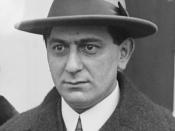The beginnings of the fairy tale musical began the mold to which all others would surely follow. The Love Parade, starring Jeanette MacDonald as the Queen of Sylvania and Maurice Chevalier as Count Renard, was one of the earliest films in this sub-genre of the American film musical. The Love Parade, directed by Ernst Lubitsch, is a story of a single queen who falls in love with her military attaché from Paris who is being brought back to the queen for punishment because of his sexual scandals in France. It is easy to enjoy the film without placing much thought into the purpose of the musical numbers that are so carefully positioned within the film, or into the duality of the main characters who are so carefully stacked beside one another and are balanced throughout the film. However, to those who are knowledgeable of the way musicals are constructed, the first song, sang by Count Renard, begins the foundation on which the entire musical will be built.
The song, "Paris, Stay the Same," is perfectly constructed to fit within the larger film and meet the requirements of both a musical and the fairy tale sub-genre.
"Paris, Stay the Same," introduces the film's viewers to the male side of the story also known as: The dual focus narrative. The viewer gets a deeper understanding of both of the lead male characters through this number. Although there are differences in the social class and position of authority between the Count, his servant, and the dog, all represent the carefree, sexually driven, masculine values that set up one side of the dual narrative. According to Rick Altman in his book, "The American Film Musical", the dual focus narrative is a main ingredient in the American musical film. The two stars of the musical film are contrasted against one other from the beginning. Each explicitly represent opposing values and different ways of life. The goal of the dual focus narrative is to bring both characters together in order to resolve these opposing forces and therefore allow the two forces to fall in love. Altman writes, "Instead of focusing all its interest on a single central character following the trajectory of her progress, the American film musical has a dual focus built around parallel stars of opposite sex and radically divergent values" (p.19). The musical numbers in a musical film are there to develop the dual focus narrative. In addition, it also balances the stars against one another. In "Paris, Stay the Same," Chevalier's character is being set up as the sexy, carefree bachelor who lives in the ultimate bachelor pad with a male servant and even a male dog who share his values and way of life in stark contrast to the Queen who values a dream lover fantasy and a life with one man. Once into the movie we realize that these two forces are opposing, and this number begins the tension.
In addition to being true to the musical form, "Paris, Stay the Same." is also representative of the fairy tale form of the American film musical, in that it is teeming with sex. Altman notes, "Constantly deriving its appeal from a more or less overt display of sexual desire, the fairy tale musical demonstrates from its earliest presence on film, the extent to which it is driven by the spectators need for quasi-sexual satisfaction" (p.140). While the entire movie contains large amounts of sexual innuendo, the Paris number is particularly sexual. The Count is singing to the city of Paris. He is singing to the ladies whom he has had affairs with. "Paris, your women were good enough for me!" was one of the lines from this steamy song. At the time that this movie was made, there were censors who wanted to curb sexuality in the moving pictures and keep Hollywood from being immoral and trying to corrupt the viewers of these films. But according to Altman, Lubitch was known for his overt sexuality in his films. The way that he, and many other filmmakers, filmed the movies and wrote the scripts, it passed through the censor's hands and into the hands of the public disguised as innocent remarks and innuendo, but now blatant to the viewer of today.
Within the plot and context of the movie, "Paris, Stay the Same," is well placed and appropriate within the overall film. As noted earlier, the viewer is introduced to the main male characters and values through this song. In addition, the number plays right into the plot of the film. The viewer is drawn to Chevalier's character and we can sympathize with him having to leave this glorious bachelorhood. We also learn, through this number, that Count Renard is harmless. His sexuality is not something that should be scorned, but something that should be understood as just fun. "Paris, Stay the Same is the second musical number in the film and the first by Chevalier. The number also sets up the fairy tale diagetic world of the film. The Count, his servant, and his dog are all happy and willing to serve the one above him in class and stature. No one is sad, old, ugly, or poor and everything is wonderful (even when Renard is caught in a sexual scandal!). The viewer is therefore being brought into this fairy tale land through this song.
Lubitsch's choice of how this number was shot was profound. The entire scene is shot outside and the characters are all on balconies or in open windows. This implies leisure time and getting out or away from the confines of home. Within this number there are cross shots between Chevalier and the ladies he has been with. In addition, there are cross shots between the servant and his lady servants and between the dog and his lady dogs of the neighborhood. This three-tiered approach gives the number and plot a comedic element and a lighthearted feeling in which the rest of the storyline is built upon. Nothing in this movie is too serious and neither is anything in this musical number.
It is difficult for viewers to see that there is a purpose for the numbers that comprise the American film musical. But each viewer's mind is being manipulated by the images and scenes and writing and musical numbers of these wonderful films. Altman has looked at the entire process, right down to the musical numbers and has written what many consider, "the bible of the American film musical" (lecture notes, p.3). In looking at The Love Parade, by Altman's standards, allows us to see the apparent guidelines that most fairy tale musicals follow. "Paris, Stay the Same" is the song that begins this journey for The Love Parade. The number sets up the movie by showing us the beginning of the dual focus narrative. It is apparent who one of the main characters will be (Chevalier), and what his values are. The number also fits well into the guidelines noted by Altman of the fairy tale sub-genre. Lubitsch is well known for including much sexual innuendo and suggestion in his movies and The Love Parade is no different. This movie is saturated with sexual overtones and undertones. This sexual energy is characteristic of the fairy tale sub-genre. "Paris, Stay the Same," is also contexualized and placed within the plot to allow the viewer an insight into the characters and what is to happen next in the plot. It is obvious through the song that all men are being taken away from Paris back to Sylvania for some reprimand. Although this is the case, all of the men involved are happy to have had the experience and are lighthearted and willing to travel back to Sylvania together. This number is a wonderful beginning to a well thought out and yet predictable fairy tale musical of the 1930's.


